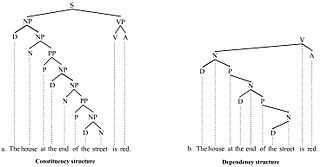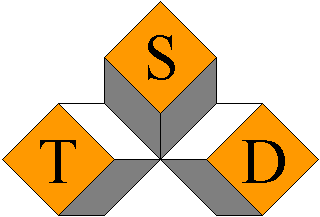Corpus linguistics is an empirical method for the study of language by way of a text corpus. Corpora are balanced, often stratified collections of authentic, "real world", text of speech or writing that aim to represent a given linguistic variety. Today, corpora are generally machine-readable data collections.
Speech synthesis is the artificial production of human speech. A computer system used for this purpose is called a speech synthesizer, and can be implemented in software or hardware products. A text-to-speech (TTS) system converts normal language text into speech; other systems render symbolic linguistic representations like phonetic transcriptions into speech. The reverse process is speech recognition.
In linguistics and natural language processing, a corpus or text corpus is a dataset, consisting of natively digital and older, digitalized, language resources, either annotated or unannotated.
The American National Corpus (ANC) is a text corpus of American English containing 22 million words of written and spoken data produced since 1990. Currently, the ANC includes a range of genres, including emerging genres such as email, tweets, and web data that are not included in earlier corpora such as the British National Corpus. It is annotated for part of speech and lemma, shallow parse, and named entities.

In linguistics, a treebank is a parsed text corpus that annotates syntactic or semantic sentence structure. The construction of parsed corpora in the early 1990s revolutionized computational linguistics, which benefitted from large-scale empirical data.
Statistical machine translation (SMT) was a machine translation approach, that superseded the previous, rule-based approach because it required explicit description of each and every linguistic rule, which was costly, and which often did not generalize to other languages. Since 2003, the statistical approach itself has been gradually superseded by the deep learning-based neural network approach.
The British National Corpus (BNC) is a 100-million-word text corpus of samples of written and spoken English from a wide range of sources. The corpus covers British English of the late 20th century from a wide variety of genres, with the intention that it be a representative sample of spoken and written British English of that time. It is used in corpus linguistics for analysis of corpora.
Chinese speech synthesis is the application of speech synthesis to the Chinese language. It poses additional difficulties due to Chinese characters frequently having different pronunciations in different contexts and the complex prosody, which is essential to convey the meaning of words, and sometimes the difficulty in obtaining agreement among native speakers concerning what the correct pronunciation is of certain phonemes.
A speech corpus is a database of speech audio files and text transcriptions. In speech technology, speech corpora are used, among other things, to create acoustic models. In linguistics, spoken corpora are used to do research into phonetic, conversation analysis, dialectology and other fields.

IraqComm is a speech translation system that performs two-way, speech-to-speech machine translation between English and colloquial Iraqi Arabic. SRI International in Menlo Park, California led development of the IraqComm system under the DARPA program Spoken Language Communication and Translation System for Tactical Use.
A non-native speech database is a speech database of non-native pronunciations of English. Such databases are used in the development of: multilingual automatic speech recognition systems, text to speech systems, pronunciation trainers, and second language learning systems.
A spoken dialog system (SDS) is a computer system able to converse with a human with voice. It has two essential components that do not exist in a written text dialog system: a speech recognizer and a text-to-speech module. It can be further distinguished from command and control speech systems that can respond to requests but do not attempt to maintain continuity over time.
Audio mining is a technique by which the content of an audio signal can be automatically analyzed and searched. It is most commonly used in the field of automatic speech recognition, where the analysis tries to identify any speech within the audio. The term ‘audio mining’ is sometimes used interchangeably with audio indexing, phonetic searching, phonetic indexing, speech indexing, audio analytics, speech analytics, word spotting, and information retrieval. Audio indexing, however, is mostly used to describe the pre-process of audio mining, in which the audio file is broken down into a searchable index of words.
Mobile translation is any electronic device or software application that provides audio translation. The concept includes any handheld electronic device that is specifically designed for audio translation. It also includes any machine translation service or software application for hand-held devices, including mobile telephones, Pocket PCs, and PDAs. Mobile translation provides hand-held device users with the advantage of instantaneous and non-mediated translation from one human language to another, usually against a service fee that is, nevertheless, significantly smaller than a human translator charges.

Text, Speech and Dialogue (TSD) is an annual conference involving topics on natural language processing and computational linguistics. The meeting is held every September alternating in Brno and Plzeň, Czech Republic.
The following outline is provided as an overview of and topical guide to natural-language processing:
Julia Hirschberg is an American computer scientist noted for her research on computational linguistics and natural language processing.
The Arabic Speech Corpus is a Modern Standard Arabic (MSA) speech corpus for speech synthesis. The corpus contains phonetic and orthographic transcriptions of more than 3.7 hours of MSA speech aligned with recorded speech on the phoneme level. The annotations include word stress marks on the individual phonemes.
The Persian Speech Corpus is a Modern Persian speech corpus for speech synthesis. The corpus contains phonetic and orthographic transcriptions of about 2.5 hours of Persian speech aligned with recorded speech on the phoneme level, including annotations of word boundaries. Previous spoken corpora of Persian include FARSDAT, which consists of read aloud speech from newspaper texts from 100 Persian speakers and the Telephone FARsi Spoken language DATabase (TFARSDAT) which comprises seven hours of read and spontaneous speech produced by 60 native speakers of Persian from ten regions of Iran.



